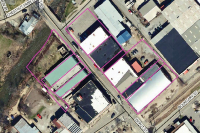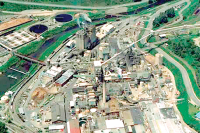No time to relax: Smokies air quality has improved, but a new ozone standard is on its way
 Breathing easy in the Smokies is a better bet than it’s been in decades. Ozone pollution is down 36 percent, and particle pollution has been cut in half. The mountain view on the haziest days now extends nearly four times as far as it did in 1998. Streams harmed by acid rain are starting to recover.
Breathing easy in the Smokies is a better bet than it’s been in decades. Ozone pollution is down 36 percent, and particle pollution has been cut in half. The mountain view on the haziest days now extends nearly four times as far as it did in 1998. Streams harmed by acid rain are starting to recover.
All stats that are cause for celebration, said a group of air quality leaders gathered on Purchase Knob in the Great Smoky Mountains National Park last week.
“The air quality is significantly better than it was 10 years ago, 15 years ago,” said Jim Renfro, air quality program manager for the park.
But that doesn’t mean it’s time to sit back and relax. Air quality is a moving target, with regulations, technologies — and the number of people using them — changing all the time.
“We’ve got to stay on our toes, keep looking at innovations and ways to reduce emissions,” Renfro said. “We can’t just sit back because we’re going to keep growing, and people are going to keep coming here.”
One target that’s about to move is the ozone standard.
Related Items
Ground-level ozone is a different beast than the atmospheric ozone that blocks ultra-violet radiation. A concoction of nitrogen oxide and volatile organic compounds reacting with sunlight, the gas causes respiratory issues in people and can harm plants and animals.
The levels have been trending downward ever since the late 1990s, when the regulated measurement (fourth highest eight-hour average for each year averaged over three years) in the park for 1997-1999 hovered between 100 and 105 parts per billion. More recently, the 2011-2013 period yielded values between 60 and 70 parts per billion, all well below the 2008 standard of 75 parts per billion — and even further below the initial 1997 standard of 85 parts per billion.
But the Environmental Protection Agency will release new guidelines in October, putting the standard even lower — probably somewhere between 65 and 70 parts per billion. By October 2017, the EPA will have a map showing which areas meet the new standard and which don’t.
Technically, the park is a nonattainment area even under the current standard. When the 2008 standard first hit the books in 2012, measurements from a park monitor at Look Rock in Tennessee were one part per billion over the standard. All levels are kosher now, and the park has already sent its paperwork off to the EPA to get off the nonattainment list.
“There could be a headline any day this summer saying Knoxville — including the Great Smoky Mountains National Park — is meeting the ozone standards,” Renfro said.
There’s not much to do but wait and see what the new standard ends up being. But the park has been working with the EPA to come up with a secondary ozone standard as well, one to protect vegetation.
“It’s more than just spots on leaves,” Renfro said of ozone’s impact to plants. “It can change ecosystem function and structure.”

According to a pair of 2007 papers by S.B. McLaughlin and other authors, high ozone levels cause forest growth to slow, contributing to growth reductions of 30 to 50 percent. Trees’ response to high ozone levels can deplete soil moisture around their roots, increase their nighttime respiration and cut down on late-season stream flow through forests.
Research into the effects of ozone on vegetation has been going on in the park since 1982, Renfro said, with National Park Service research contributing to the EPA’s scientific review of what the ozone standard should be. Now, the park is trying to figure out how high ozone levels must get before harming the plants.
The EPA developed maps for a whole slew of tree species, correlating their level of exposure in a certain area with the percent decline in growth that species experienced. As it turns out, some species are hardier than others. For instance, at an ozone level that caused growth declines of 39 to 52 percent in black cherry, red maple experienced only a 2 to 3 percent reduction.
The secondary standard for vegetation wouldn’t likely have “teeth” like the primary standard does. If you’re a nonattainment area for the EPA’s ozone standard, then the state has to develop a plan — which the EPA must approve — outlining the path to reaching attainment. That can mean additional regulations on the area in question. The secondary standard would likely be more of an “FYI standard” — a number that’s out there so people know what the current ozone level means for plants.
But it’s possible that the primary standard could take care of a lot of the vegetation-related concerns.
“If EPA sets the primary standard at 65 [parts per billion] for people, I would be pretty satisfied for the Southern Appalachians and the Smokies,” Renfro said, though adding that vegetation in the western states would require a lower standard.
Of course, if the standard is lowered, more areas currently having no trouble complying would be labeled nonattainment and have to deal with any restrictions and red tape accompanying that designation. There will be a time for states to let the EPA know what impact the new rule will have on their jurisdiction once the proposal comes out.
“There’s going to be time for the states to react to what they recommend, what are the nonattainment areas the states think should be designated,” Renfro said.
Be heard
The Department of Air Quality is currently accepting comments on the draft plan, which is available at www.ncair.org/monitor/monitoring_plan/new_plan. After the comment period closes July 2, DENR will make any necessary changes before submitting the plan to the EPA for final approval. Comments can be sent to
This email address is being protected from spambots. You need JavaScript enabled to view it.
Dr. James Bowyer,
N.C. Division of Air Quality,
1641 Mail Service Center,
Raleigh, North Carolina 27699-1641
The DAQ’s fax number,
919.707.8467
Waynesville air quality monitor to be axed
You don’t always know what you don’t know, but the more you know the less you don’t know.
At least, that’s the position of air quality managers in Western North Carolina upset about a recently released draft plan from the N.C. Department of Environment and Natural Resources to shut down nine stations monitoring pollution from particulate matter and three monitoring ozone — among them, a station that’s recorded particle pollution in Waynesville since 1999.
“That Waynesville monitor is in Waynesville, but it represents areas in the national park system — the Blue Ridge Parkway and the Smokies,” said Jim Renfro, Smokies air quality program manager. “It gives us a lot of information that we’re going to lose if we lose these monitors that we spent a lot of energy, a lot of partnerships, to build.”
Particulate matter is inhalable, and it can work its way deep into the lungs and even the bloodstream. It also fogs up the view, impairing the vistas that park visitors cite as the number one reason to see the Smokies.
West of Asheville, the only stations monitoring particulate matter are in Waynesville, Bryson City and Cherokee, but the station in Cherokee is operated by the Eastern Band of Cherokee Indians, not by DENR. So, if the Waynesville station closes at the end of the year in accordance with the proposed plan, the Bryson City station will be the only state-operated monitor in the far western part of the state.
“It’s going to reduce the network quite a bit,” said Steven Ensley, air-monitoring coordinator for the western region.
The decision will certainly mean fewer monitors, but it won’t necessarily take away vital data, said Tom Mather, public information officer for DENR’s Division of Air Quality.
“The air quality has improved so much that a lot of these measurements we’re getting are so far below the standard that we don’t expect any problems,” Mather said.
He’s right about levels staying below the standard. In the 1999-2001 period, Haywood County was sitting right at the standard of 15 micrograms of particles larger than 2.5 micrograms per cubic meter. By 2011-2013, the figure had fallen to 9 micrograms per cubic meter, far below the revised standard of 12 micrograms per cubic meter.
Continued monitoring didn’t seem all that necessary, and due to new monitoring requirements for sulfur dioxide, DENR felt it best to put resources toward those newly required monitors rather than toward monitors like the Waynesville one, whose data has repeatedly shown that the numbers are good, Mather said.
“We’re not always closing monitors,” Mather said. “Sometimes we’re opening new ones.”
Mather couldn’t say whether any of the new sulfur dioxide monitors would be located in Western North Carolina.
Renfro takes issue with DENR’s reasoning. For one thing, he said, more data is always good because more data leads to better management decisions. And for another, it’s dangerous to assume that any trend will continue forever.
Take mercury for example. From about 2004 to 2008, mercury deposition in the park was trending down, falling from 16 nanograms per cubic meter to 11.3. But then, the trend reversed, levels climbing slowly upward before shooting from 14.8 to 20.1 nanograms per cubic meter between 2012 and 2013. In 2014, the level fell back slightly to 19.6 nanograms per cubic meter.
“That’s what monitoring can do. It can surprise you,” Renfro said. “If someone says, ‘We think particulates will continue to go down in Waynesville even though you don’t have a monitor,’ well maybe. We don’t know.”









